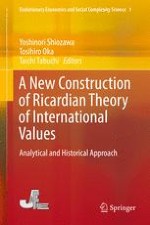Two rare analyses on the theory of international economics with linear economics exist that have different lines of thought but similar model specifications. One is the analysis of (production-)efficient patterns of specialization that allows intermediate goods with the Ricardo–Leontief model and that belongs to the field of modern economics. The other is the Sraffa model extended to international economy, which does not belong to the field of modern economics. In the model setting, the difference between the two analyses is whether the rate of profit exists or not, although the meanings whether the rate of profit exists or not are very different. However, at least in the era of Deardorff (
2005a), only the definition of comparative advantage, including intermediate inputs, is not determined and has been the focus since McKenzie (
1954a,
b,
1955) and Jones (
1961) analyzed the pattern of specialization in the multi-country, multi-good Ricardo–Graham model. Shiozawa (
2007) made progress on this subject by extending the Sraffa model internationally on the evolutionary economics front but not in modern economics. In this subject, the solution to the problem which these analyses focus on is the production-efficient pattern of specialization; however, there are two problems with this approach. First, in the case where the number of goods is larger than that of countries, the efficient pattern of specialization essentially does not exist. Focusing on this case, Shiozawa (
2007) showed the extended concept of pattern of specialization, i.e., “shared pattern of specialization,” and pointed out the importance of the case in the real-world economy. Second, as in Higashida (
2005a, Japanese), which uses illustrations of price and specialization traditionally presented in Amano (
1966) and Ikema (
1993, Japanese), the (production-)efficient pattern of solution is not unique in the case of Jones’ (
1961) setting allowing intermediate goods. Jones (
1961) focused on the “production assignment problem” between technological parameters to determine (production-)efficient pattern of specialization. To solve the problem, Jones (
1961) uses the method of the Hawkins–Simon theorem, where the concept of
Z-matrix is the easier treatable concept of the linear complementarity problem. Higashida’s (
2005b) result means that the (production-)efficient pattern of specialization cannot be determined easily with only a simple extension to Jones’ (
1961) way. Considering the solution in the case allowing intermediate inputs, the more difficult concept—the
S-matrix—which does not have the equivalent concept, must be used. Thus, the final solution, i.e., the necessary and sufficient technological parameters’ condition that determines the (production-)efficient pattern of specialization, may not exist. Shiozawa (
2007) showed the general existence of a solution, considering the case allowing the number of goods is larger than that of countries (which may become the last meaningful progress of the model analysis), if the simple and meaningful economic condition like Jones’ inequality does not appear. Shiozawa (
2014, Japanese) saw through this and positioned the result as a “final solution,” giving historical meaning to evolutionary economics. However, this progress has implications for not only evolutionary economics but also modern economics. This chapter discusses the significance of Shiozawa’s progress in terms of modern economics and in the context of historical illustrations.
